Invasive Species And Pests
Invasive species are non-native species whose introduction to an ecosystem causes harm to the environment, economy or human health. They are generally aggressive species that out-compete and can eradicate native species. In Hawaii (known as “ground zero for invasive species” and the “extinction capital of the world”), invasive species are accelerating the rate of extinction of native species, spreading into and causing the loss of native forest communities, and negatively impacting Hawaii’s watersheds, agriculture, human health and overall economy.
Since the 1700’s, at least 5,000 plant species have been introduced into Hawaii. 1500 of these introduced species have naturalized, with 200 aggressively outcompeting native flora. As a result, 54% of Hawaiian flora has been impacted.
“In 1994, the federal Office of Technology Assessment declared Hawaii’s alien pest species problem the worst in the nation…”
A summary of the extreme harm caused by invasive species on Hawaii’s native flora and fauna was recently published by the US Forest Service. The following link contains information on this summary: Regional Summaries: Hawaii and US-Affiliated Pacific Islands (fs.fed.us). The actual summary can be read at Appendix: Regional Summaries: Hawaii and US-Affiliated Pacific Islands (fs.fed.us)
The degradation and loss of 90% to 95% of native dryland ecosystems is staggering. Factors that have brought about these changes continue to be threats to what little dry forest remains. Human behavior and the way we think about our native life can greatly impact the future and whether generations to come will be able to experience native dryland communities.
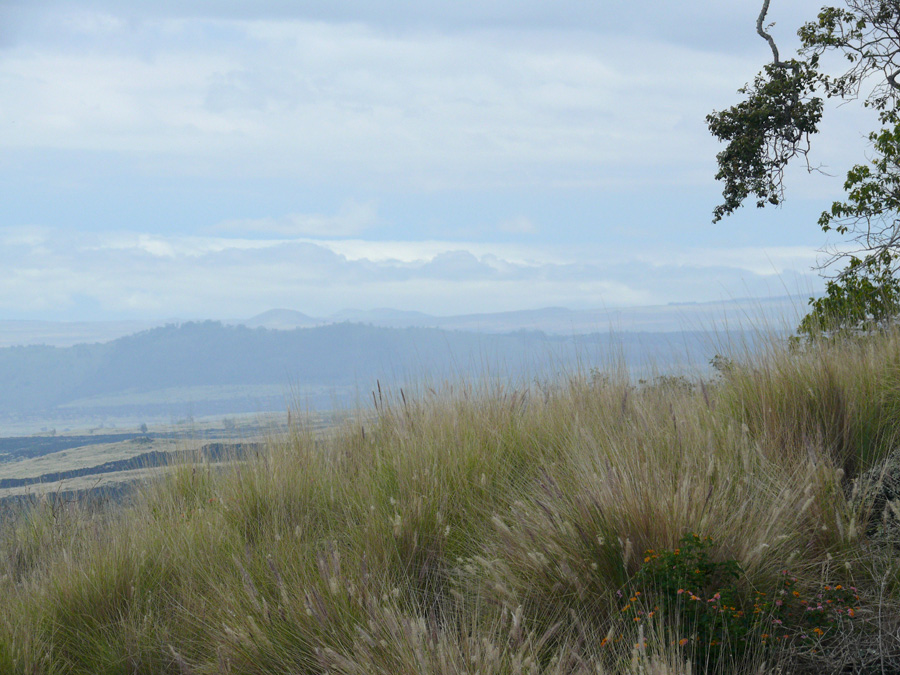
Invasive Fountain grass dominates Hawaii’s landscapes, where once there was dry forest
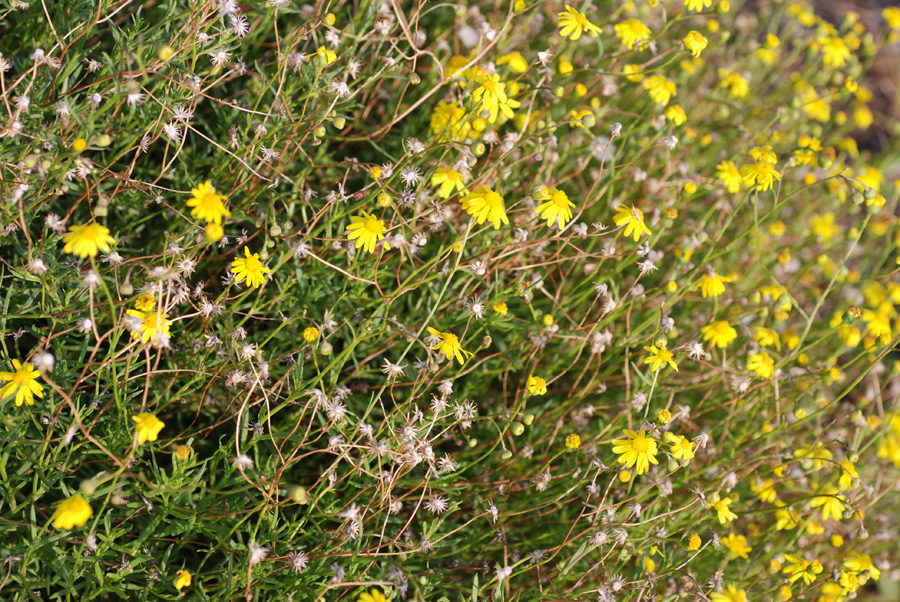
Invasive Fireweed © Yvonne Yarber Carter
Invasive species are involved in many of the drivers causing the loss of native dry forest ecosystems:
- Human use and development, including the introduction of many invasive species of plants, microorganisms and insects
- Wildfire, which is exasperated by fuel loading from invasive grasses—particularly fountain grass
- Feral and invasive ungulates (mammals with hoofs like goats, sheep and cattle) that graze and eradicate native plants
- Predation of native plant seeds and native bird eggs by invasive rats and mongoose
- Loss of pollinators, many of which have been impacted by invasive species
- Changes to soil properties and hydrological processes with cascading effects on lowland coastal areas and ocean reefs.
Major Threats to Hawaii’s Dry Forest
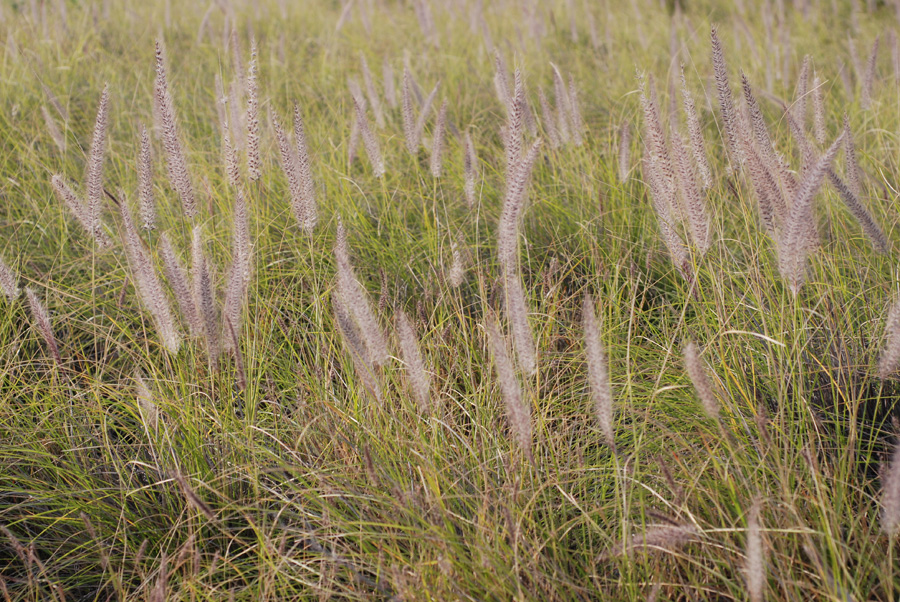
Invasive fountain grass. © Yvonne Yarber Carter
Fountain Grass
The greatest invasive plant threat to the dry forests in West Hawaii is fountain grass, which was introduced at a ranch in the North Kona area as an ornamental close to 100 years ago. It now covers over two hundred thousand acres in the Kona and Kohala region of Hawaii Island and continues to spread at an alarming rate.
It is a highly fire-prone plant which is also fire adapted, meaning it survives and spreads even more by wildfire. Thus it not only is a major contributor to the spread of wildfires impacting native forests, it also out competes and prevents the regrowth of native species after fires. It is this grass-fire cycle which has contributed to the vast savannas of fountain grass in West Hawaii. You can learn more about this highly invasive grass at the following websites:
Rapid ʻŌhiʻa Death
In 2014 another major invasive threat to all forests throughout Hawaii was identified: a fungus called Ceratocystis, which causes Rapid ʻŌhiʻa Death. ʻŌhiʻa trees are the foundational and most abundant tree (~ 80%) of Hawaiian native forests, so loss of this key species is of utmost concern across the State of Hawai’i. The fungus is a wound pathogen, i.e. it enters ʻōhiʻa through wounds in the tree. The fungus colonizes the sapwood of an infected ʻōhiʻa tree, and virtually robs the tree of the water and nutrients it needs to survive.
The following video provides more information on this major threat and what you can do to help prevent its spread:
Visit the following website for the latest information on Rapid ʻŌhiʻa Death, including research findings and maps showing where it is located: rapidohiadeath.org
For in-depth scientific research on Rapid ʻŌhiʻa Death, please see the many videos from the 2019 Science Symposium: 2019 Rapid ʻŌhiʻa Death Science Symposium
If you would like to help with conservation efforts for ʻōhiʻa, please visit the Ōhiʻa Love page.
Naio Thrips and Erythrina Gall Wasps
Two other invasive insects have also taken a huge toll on dry forests in Hawaii, impacting the leaves of native Naio and Wiliwili trees, thus severely impacting the photosynthesis needed for the trees’ survival:
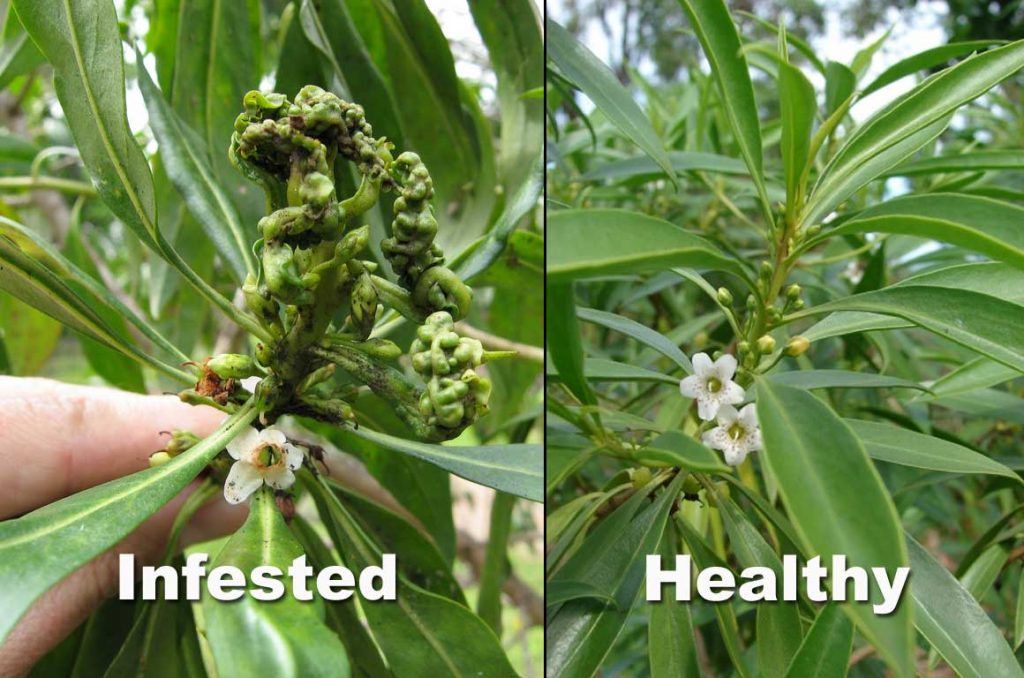
Infested and healthy Naio (Myoporum sandwicense). Photo Credit: Hawaii Department of Land and Natural Resources

Galls from Erythrina gall wasps on infected Wiliwili leaves. Photo Credit: Hawaii Department of Agriculture
For more information on the these invasive insects and their impacts, please refer to the following:
- Hawaii Department of Land and Natural Resources: Naio Thrips
- 2013 Nāhelehele Dryland Symposium video: Myoporum Thrips in Hawai’i
- Hawaii Department of Land and Natural Resources: Erythrina Gall Wasp
Ungulates and Other Introduced Animals
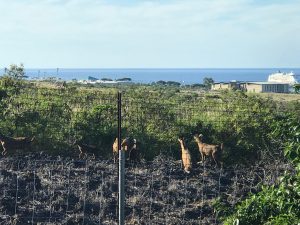
Goats at Laiopua, Credit: Jill Wagner
Ungulates (mammals with hoofs) have also severely impacted the dryland ecosystem landscape. Prior to human arrival in the Hawaiian Islands, ungulates did not exist here. As a result, native Hawaiian plants lack the common defenses to browsing and trampling that plants developed elsewhere (e.g. bitter taste, thorns), thus were highly grazed and trampled by domestic and feral ungulates.
This is why fencing is so important as a conservation strategy in Hawaii. Following are several papers to begin exploration of this threat:
Controlling Ungulate Populations In Native Ecosystems In Hawaii. A Position Paper by the Hawaii Conservation Alliance that states, “Ungulates impede the progress of conservation and restoration of native Hawaiian ecosystems. Ungulate removal, in conjunction with other management actions, is necessary to ensure the success of ecosystem restoration and preservation of native Hawaiian ecosystems.”
Biology and Impacts of Pacific Island Invasive Species. 9. Capra hircus, the Feral Goat (Mammalia: Bovidae) provides an excellent summary of the impacts of feral goats to Pacific Islands and management strategies to control them.
Evaluating the long-term management of introduced ungulates to protect the palila, an endangered bird, and its critical habitat in subalpine forest of Mauna Kea, Hawai‘i reviews three decades of ecological studies on feral ungulate management in the palila critical habitat area of Mauna Kea.
Goats in Hawai’i Volcanoes National Park: A Story to be Remembered is a very thorough historical account by W. Edwin (Ed) Bonsey, a volunteer with the National Park Service, about the long journey to control goats in this National Park.
Introduced Animals In Hawaii’s Natural Areas
CHARLES P. STONE and STEPHEN J. ANDERSON, Hawaii Field Research Center, Hawaii Volcanoes National Park,
ABSTRACT: The Hawaiian islands provide superlative examples of biological evolution and are perhaps the best sites in the world for biological invasions. Introduced invertebrates such as the Argentine ant (Iridomyrmex humilis) and the western yellowjacket wasp (Paravespula pensvlvanica) reduce native insects and plant pollinators and may have been a factor in native bird declines. … Research on the long term effects of alien birds on native ecosystems is under way, but management currently is restricted to preservation of intact and large areas of native ecosystems. Black rats (Rattus rattus), small Indian mongooses (Herpestes auropunctatus). and feral cats (Felis catus) are thought to be especially important invaders of natural areas in Hawaii. … Ungulates have been the most prominent alien animals in Hawaii’s ecosystems since shortly after continental man introduced them in the 18th century. Successful control and even eradication of feral cattle (Bos taunis), feral sheep (Qvisaries), mouflon (Ovismusimon). feral goats (Capra hircus), and feral pigs (Sus scrofa) has been accomplished in many areas to date through systematic, long-term programs with salaried personnel. Methods and costs of some of these programs are presented.
Additional Information on Invasive Species
There are numerous organizations dedicated to conservation and management of negative impacts to native ecosystems. Following are several of these organizations working to lessen the impact of invasive species in Hawai’i. Their websites provide many resources and additional links.
- Hawai’i Invasive Species Council is a Hawai’i State inter-departmental effort formed “for the control and eradication of harmful invasive species infestations throughout the State and for preventing the introduction of other invasive species that may be potentially harmful. The HISC fulfills its mandate by issuing resolutions, providing plans, and strategically disbursing funds to enhance invasive species prevention, control, outreach, and research.”
- The Coordinating Group on Alien Pest Species (CGAPS) is a voluntary partnership of federal and state agencies and non-governmental organizations whose goal is to protect Hawaiʻi from invasive species that impact the economy, environment, agriculture, and public health.
- HEAR (Hawaiian Ecosystems at Risk) The mission of the Hawaiian Ecosystems at Risk project (HEAR) is to provide technology, methods, and information to–and to facilitate communication among–decision-makers, resource managers, and the general public to help support effective science-based management of harmful non-native species in Hawai’i and the Pacific. Tips to “stop the alien invasion” and information can be found at these links: http://www.hear.org/intro/pg26b.htm and http://www.hear.org/intro/pg01-2.htm
- Plant Pono is a project of the Coordinating Group on Alien Pest Species, the Hawai’i Invasive Species Council, and the Hawai‘i Biological Information Network with excellent information on making wise planting decisions to protect Hawaii’s ‘aina. Their new search tool for selecting pono plants for your growing conditions is very helpful. They also provide information on what invasive species not to plant.
- Conservation Council for Hawai`i (CCH) is a non-profit dedicated to protecting and advocating for native ecosystems. Educators may find their educational posters celebrating Hawaiian wildlife and wild places very useful. They are distributed free of charge and downloadable at https://conservationcouncilhawaii.org/teacher-guide-and-poster/
- The Hawai‘i Conservation Alliance (HCA) is a collaboration of conservation leaders representing government, cultural, educational, and non-profit organizations from across the state that are strongly committed to perpetuate native ecosystems and ensure their unique biodiversity endures in the Hawaiian Islands
